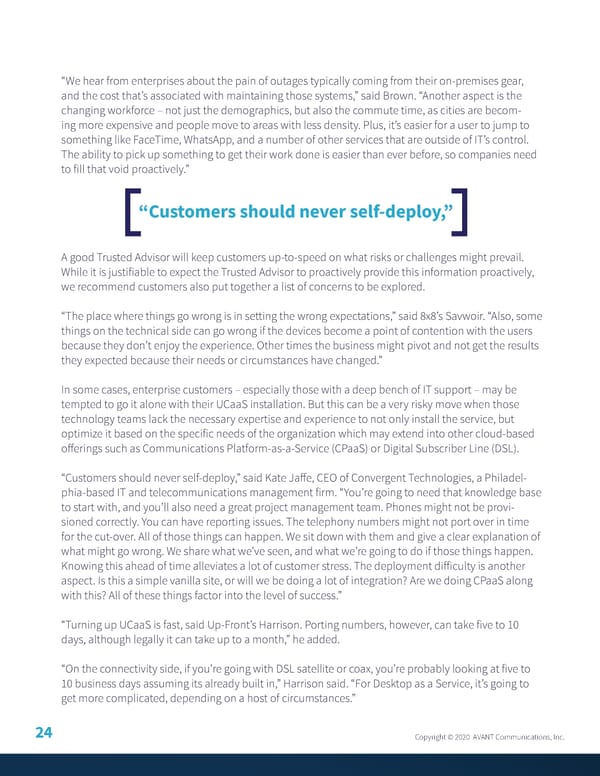“We hear from enterprises about the pain of outages typically coming from their on-premises gear, and the cost that’s associated with maintaining those systems,” said Brown. “Another aspect is the changing workforce – not just the demographics, but also the commute time, as cities are becom- ing more expensive and people move to areas with less density. Plus, it’s easier for a user to jump to something like FaceTime, WhatsApp, and a number of other services that are outside of IT’s control. The ability to pick up something to get their work done is easier than ever before, so companies need to fill that void proactively.” “Customers should never self-deploy,” A good Trusted Advisor will keep customers up-to-speed on what risks or challenges might prevail. While it is justifiable to expect the Trusted Advisor to proactively provide this information proactively, we recommend customers also put together a list of concerns to be explored. “The place where things go wrong is in setting the wrong expectations,” said 8x8’s Savwoir. “Also, some things on the technical side can go wrong if the devices become a point of contention with the users because they don’t enjoy the experience. Other times the business might pivot and not get the results they expected because their needs or circumstances have changed.” In some cases, enterprise customers – especially those with a deep bench of IT support – may be tempted to go it alone with their UCaaS installation. But this can be a very risky move when those technology teams lack the necessary expertise and experience to not only install the service, but optimize it based on the specific needs of the organization which may extend into other cloud-based offerings such as Communications Platform-as-a-Service (CPaaS) or Digital Subscriber Line (DSL). “Customers should never self-deploy,” said Kate Jaffe, CEO of Convergent Technologies, a Philadel- phia-based IT and telecommunications management firm. “You’re going to need that knowledge base to start with, and you’ll also need a great project management team. Phones might not be provi- sioned correctly. You can have reporting issues. The telephony numbers might not port over in time for the cut-over. All of those things can happen. We sit down with them and give a clear explanation of what might go wrong. We share what we’ve seen, and what we’re going to do if those things happen. Knowing this ahead of time alleviates a lot of customer stress. The deployment difficulty is another aspect. Is this a simple vanilla site, or will we be doing a lot of integration? Are we doing CPaaS along with this? All of these things factor into the level of success.” “Turning up UCaaS is fast, said Up-Front’s Harrison. Porting numbers, however, can take five to 10 days, although legally it can take up to a month,” he added. “On the connectivity side, if you’re going with DSL satellite or coax, you’re probably looking at five to 10 business days assuming its already built in,” Harrison said. “For Desktop as a Service, it’s going to get more complicated, depending on a host of circumstances.” 24 Copyright © 2020 AVANT Communications, Inc.
 UCaaS trends Page 25 Page 27
UCaaS trends Page 25 Page 27